Mystery of the Arnold House Shards
During the 1962-1965 restoration of the Thankful Arnold House workmen found hundreds of pieces (shards) of pottery and porcelain in the wall cavity between the back parlor and 1750 ell addition. A few of the pieces were glued together for display but the rest were stored in boxes and placed in the attic where they languished for almost thirty-five years.
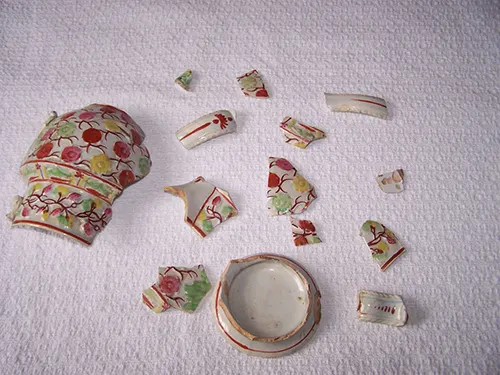 In 1999 the shards were 'rediscovered' and a group of interested parties lead by former director Jan Sweet started the process of washing, sorting and gluing the shards back together. Archeologist Robert Gradie was contacted to work with the group to help determine the age and uses of the shards. The pieces were first sorted by color and material and then again by function. The last sort was to gather all the available parts of each object and glue them back together. The time frame of the shards ranges from items that belonged to the Arnolds as newlyweds (1796) to dishes that were bought within a few years of Thankful's death in 1847.
In 1999 the shards were 'rediscovered' and a group of interested parties lead by former director Jan Sweet started the process of washing, sorting and gluing the shards back together. Archeologist Robert Gradie was contacted to work with the group to help determine the age and uses of the shards. The pieces were first sorted by color and material and then again by function. The last sort was to gather all the available parts of each object and glue them back together. The time frame of the shards ranges from items that belonged to the Arnolds as newlyweds (1796) to dishes that were bought within a few years of Thankful's death in 1847.
Among the many puzzling questions that came to mind while looking at the hundreds of pieces of pottery were three basic ones:
Why were the dishes broken?
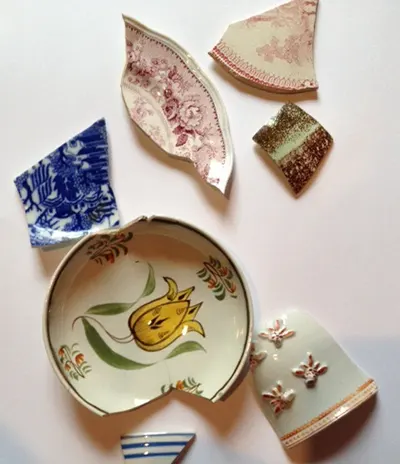
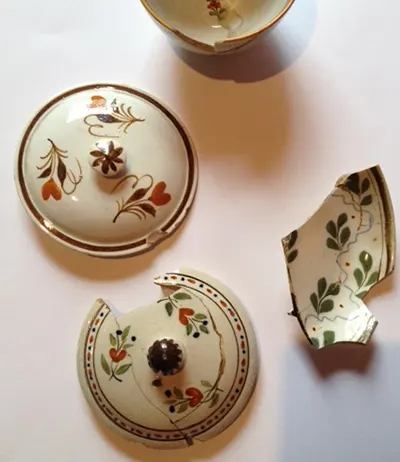
According to social historian Dawn Adiletta, there were two times women traditionally discarded what we would now think as valuable items. When a man remarried, the new wife might take the belongings of her predecessor and put them down the outhouse. Similarly, a daughter-in-law who had lived with her husband's parents might establish her new role as mistress of the household by removing her deceased mother-in-law's belongings. Two hundred years ago people were not interested in antiques. So these women got rid of that "old stuff" because they wanted what was new and fashionable.
Of course, none of the Arnold family's second wives or daughters-in-law ever lived in the house on Hayden Hill. But there was Nancy, Thankful's eldest daughter. Born in 1800, she lived her whole life in the family homestead. Nancy may have cleaned house when her mother died. It's possible Nancy may have been angry at having spent her whole life helping to care for her younger brothers and sisters, and then for an infirm Thankful. Another possibility is that rather than discard broken dishes in a pile out in the back yard they were discreetly hidden in the wall rather than be in plain view of the family and neighbors.
A visitor to the Arnold House once suggested that a small river boat may have used the broken dishes as ballast and unloaded them on shore where the Arnold Family picked them and brought them home to use in the wall void. Others have suggested the dishes were items that were to be sold in Joseph’s store but arrived broken and stock-piled until another use could be found for them.
It is not clear why the dishes were broken or even where they came from. New Englanders were, as a rule, very frugal, and it seems unlikely that they would have broken and discarded dishes on purpose.
Why were the shards in the wall?
Shards (of a large quantity) have been found in the walls of only three houses in Connecticut. Why they were placed in the wall may be partly a matter of the construction of the Arnold House. The wall where the shards were located is where the 1750 building was attached to what had been an outside wall of the 1800 addition. Both structures consisted of clapboards nailed to the outside of a row of planks and lathing and then plaster attached to the inside. Houses built in this manner have very narrow walls. However, when two buildings are joined a gap is created between them. One theory is that Nancy, ever practical, used this gap to dispose of the broken china and block the passage of mice. It is also possible they thought the dishes interspersed with the corn cobs may have provided a form of insulation or sound proofing.
What can we learn about the Arnold Family based on the items that they owned?
As the shards were sorted, catalogued and glued together, archeologist Robert Gradie put together pieces of the lives of the Arnold Family. The personal taste, their economic fortunes, and even personal details, such as the ceramic bedpan which may tell of Thankful's health problems, are all revealed in these objects. Although not all of the shards have been put back together, representative selections are on display at the Arnold House and we encourage you to come and view them.
Unsolved mystery?
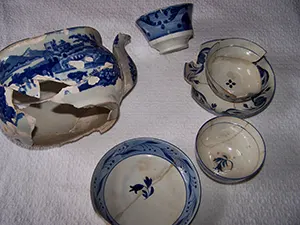
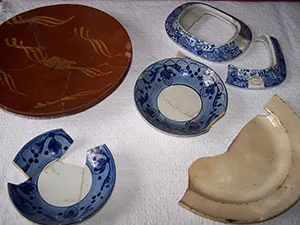
At this time we don't know how many shards we have, nor how many separate objects there are. A rough guess is that 10% is red ware, American pottery dating from 1790 to 1810. Another 85% is English china made before 1850, and perhaps 4% is Chinese export. The remaining 1% is a mystery. Most of the objects tossed in the wall can be reconstructed almost in their entirety. However there are several small pieces which represent all that is left of four objects. These fragments have left the experts perplexed. One piece was determined to be from South America and how it ended up in the wall of the Thankful Arnold House remains a mystery.
